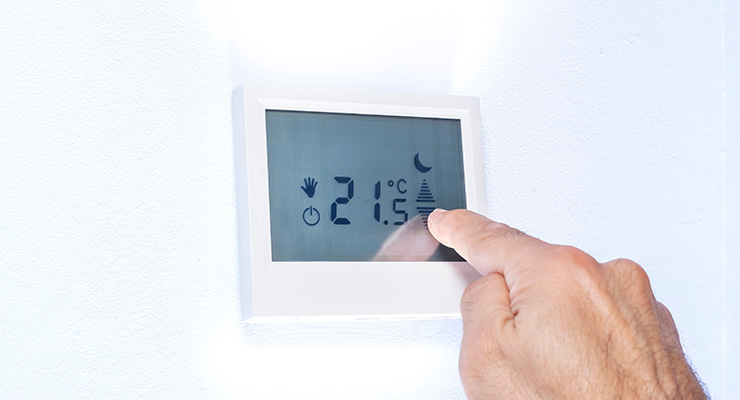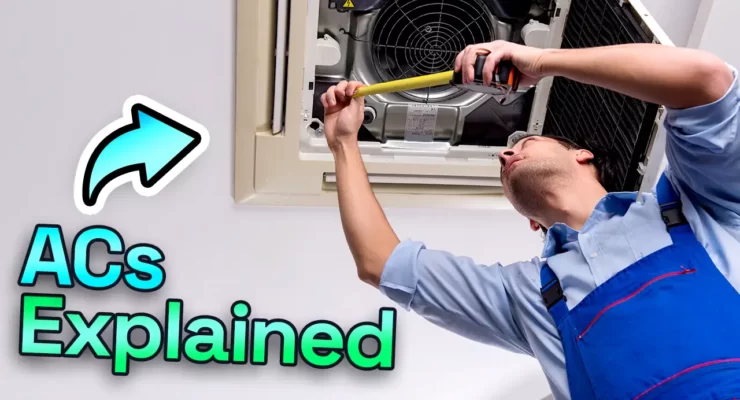Fast read
Your air conditioner functions as a heat transfer machine, extracting warmth from inside your home and expelling it outside. Its main components include the evaporator coil, compressor, condenser coil, and expansion valve. Warm air is drawn in, passing over the evaporator coil where the refrigerant absorbs heat, causing the air to cool.
The heat is absorbed and turns the refrigerant into a low-pressure gas. The compressor then compresses the gas, making it hotter. This hot gas releases its heat outdoors via the condenser coil. The refrigerant is then condensed back into a liquid by the expansion valve, ready to repeat the cycle.
This process continually removes heat from indoor air, keeping your home comfortable. Modern air conditioners also feature thermostats for control and air filters for allergen removal, while advancements improve energy efficiency ratings.
How Does Your Air Conditioner Work?
Keeping your home cool in hot summers is important. But have you ever wondered how your air conditioner works?
It’s not as complicated as you might think, rather than making cold air, your AC actually moves heat from inside your home to the outside.
Think of your air conditioner as a heat mover, here’s how your air conditioner works:
Inside your AC, there’s a special liquid called refrigerant, it turns into a gas, soaking up heat from your home’s air.
The gas is then squeezed into a high-pressure form, making it scorching hot, it releases the heat outside and turns it back into a liquid. Now, the liquid goes back indoors, where it expands and cools down again, this helps it soak up more heat from your home, keeping you cool.
Understanding this simple process helps you appreciate the magic of your air conditioner. So, next time you feel that cool air, you’ll know how it’s keeping you comfortable.
The Essential Elements:
Just like any well-oiled machine, an air conditioner works by relying on a set of key components to perform its task:
- Evaporator Coil: This is the cooling coil, usually located indoors. Filled with a special liquid called refrigerant.
- Compressor: This acts as the system’s heart, using electricity to compress and pressure the refrigerant.
- Condenser Coil: This outdoor unit releases the extracted heat to the external environment.
- Expansion Valve: This valve regulates the flow and pressure of the refrigerant.
The Cooling Cycle:

- Warm Air Intake: The air conditioner draws warm air from your home through vents.
- Heat Exchange at the Evaporator: This warm air passes over the cold evaporator coil. As the air touches the cool coils, the refrigerant inside absorbs the heat, causing the air to lose its thermal energy and cool down.
- Liquid to Gas Transformation: Simultaneously, the absorbed heat causes the liquid refrigerant inside the evaporator coil to evaporate, turning into a low-pressure gas.
- Compression for Power: The low-pressure gas then travels to the compressor. Here, the compressor acts like a pump, squeezing the gas, significantly increasing its pressure and temperature.
- Heat Release at the Condenser: The high-pressure, hot gas then flows to the outdoor condenser coil. The hot gas releases the absorbed heat to the surrounding air through the condenser fins. A fan helps to circulate air across the condenser, facilitating efficient heat release.
- Back to the Beginning: The cooled, high-pressure refrigerant moves through the expansion valve. This valve lowers the pressure of the refrigerant, converting it back into a liquid. The cooled liquid refrigerant then returns to the evaporator coil, prepared to absorb more heat and restart the cycle.
The Result:
Your air conditioner works non-stop to remove heat from your indoor air, making your space cooler and more comfortable. By understanding this essential process, you can appreciate the role your AC plays in keeping your home cosy during hot spells.
This process keeps your indoor space cool by absorbing heat, compressing it to make it hotter, and then releasing it outside. Embracing this insight into your air conditioner’s functionality enhances your awareness of its cooling prowess, allowing you to maximize comfort while minimizing energy consumption.
Beyond the Basics of how your air conditioner works:
Modern air conditioning units come equipped with advanced features such as thermostats for precise cooling control and filters that effectively eliminate dust and allergens from indoor air. Moreover, ongoing technological innovations have given rise to energy-efficient air conditioners, consuming less electricity without compromising on cooling performance.
These advancements not only enhance the comfort levels within your living space but also contribute to lower energy costs and reduced environmental impact. When you upgrade your air conditioning, consider investing in the latest technology. New features and energy-saving options can improve comfort and sustainability. It is worth the investment for better performance.
